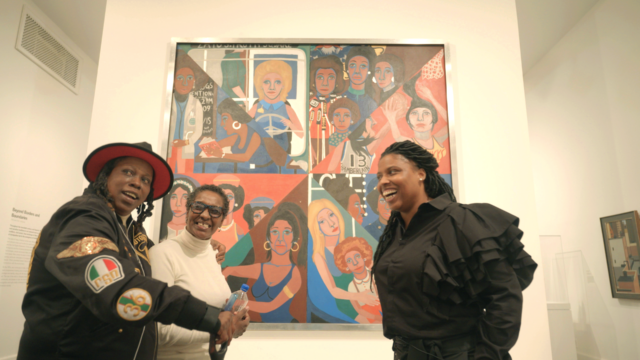
Formerly incarcerated women Enid “Fay” Owens, Nancy Sicardo, and Mary Baxter check out Faith Ringgold’s For the Women’s House in Paint Me a Road Out of Here
PAINT ME A ROAD OUT OF HERE (Catherine Gund, 2024)
Film Forum
209 West Houston St.
Opens Friday, February 7
212-727-8110
www.filmforum.org
“No one and nothing is safe at a prison, including the guards, the inmates, the walls, the furniture, and especially that painting,” author and activist Michele Wallace says in Catherine Gund’s moving and passionate documentary Paint Me a Road Out of Here, opening February 7 at Film Forum.
Author of such books as Black Macho and the Myth of the Superwoman and Dark Designs and Visual Culture, Wallace is the daughter of children’s book writer, painter, sculptor, and performance artist Faith Ringgold. The work she is referring to is her mother’s 1972 For the Women’s House, an eight-foot-by-eight-foot mural that was commissioned for the New York City Correctional Institution for Women on Rikers Island.
Before starting the mural, Ringgold visited the institution and met with some of the women. “I knew that each one wanted to be inspired, to renew their life,” she says in the film. “They wanted to be out of there, of course. And it was obvious to me that the reason why many of them were there was because they had a lack of freedom. I asked the women, ‘What would you like to see in this painting that I’m going to do to inspire you?’ And one girl said, ‘I want to see a road leading out of here.’”
The large canvas is divided into eight triangular sections depicting women in nontraditional roles, including as professional basketball players, a bus driver, a police officer, a priest, a lawyer, a construction worker, and US president, accompanied by quotes from Rosa Parks and Coretta Scott King.
“Almost every single profession in that painting was not open to women in 1971,” curator Rujeko Hockley points out. She also equates prisons with museums, noting, “Black people were held captive in one institution and excluded from the other.”
Gund traces the history of For the Women’s House, delving into its conception, detailing how it was painted over in white by prison employees in 1988, and examining its restoration and the very strange journey it took as the Brooklyn Museum attempted to acquire it in order to save it from potential oblivion. She also places it in context within Ringgold’s career, looking at her seminal 1967 breakthrough gallery show, featuring such powerful and important works as Die, The Flag Is Bleeding, and The American People Series #19: US Postage Commemorating the Advent of Black Power. She meets with Ringgold in her studio, on her porch, and at the New Museum, which eventually hosted her revelatory career retrospective, “American People,” in 2022.
The director balances that narrative with the inspirational tale of Mary Enoch Elizabeth Baxter, who gave birth while incarcerated and fought to right her life through art and activism after serving time. Baxter returns to the Riverside Correctional Facility in Philadelphia in 2022 and installs a mural comprising multiple affirmations, providing hope for the women there through art. She also developed a friendship with Ringgold.
Gund (Born to Fly: Elizabeth Streb vs. Gravity, Chavela), who participated in freeing the painting after first encountering it in late 2021, speaks with Michael Jacobson, who was the commissioner of the Dept. of Corrections in the mid-1990s when the painting virtually disappeared; artist and author Michelle Daniel Jones, who teamed up with Baxter to put on an exhibition; curators Hockley and Catherine Morris, who staged “We Wanted a Revolution: Black Radical Women, 1965–85” at the Brooklyn Museum in 2017; Rikers corrections officer Barbara Drummond, who led the fight to preserve For the Women’s House; and ACA gallerist Dorian Bergen, who explains about Ringgold’s early work, “These are among the most important paintings of the twentieth century. History had to catch up with Faith.”
The artworks shown in the film will be eye-opening to viewers who are not familiar with Ringgold’s oeuvre, from the aforementioned pieces to Childhood, The Fall of America, Sojourner Truth Tanka: Ain’t I a Woman, Uptight Negro, and Flag Is Bleeding. “I became an artist so that I could tell my story,” Ringgold, who dressed in splashy outfits with sparkling accoutrements, says, and what a story it is.
A New York City native, Ringgold passed away in New Jersey in 2004 at the age of ninety-three. Her remarkable legacy will live on in the hearts and minds of her many fans, fellow artists, and incarcerated and formerly incarcerated women who find freedom in what she stood for.
As curator and author Nicole R. Fleetwood declares, “I think art is disruptive, and I think art disrupts lazy thinking.”
There is no lazy thinking when it comes to Faith Ringgold.
[There will be a series of postscreening discussions at Film Forum, presented by the New Museum and the Women’s Community Justice Association on February 7 at 7:00, the Center for Art & Advocacy on February 8 at 7:00, the Vera Institute of Justice and Silver Art Projects on February 13 at 7:00, the New York Women’s Foundation and the Center for the Study of Women and Society at the Graduate Center on February 18 at 6:30, and the Guggenheim on February 20 at 6:30.]
[Mark Rifkin is a Brooklyn-born, Manhattan-based writer and editor; you can follow him on Substack here.]